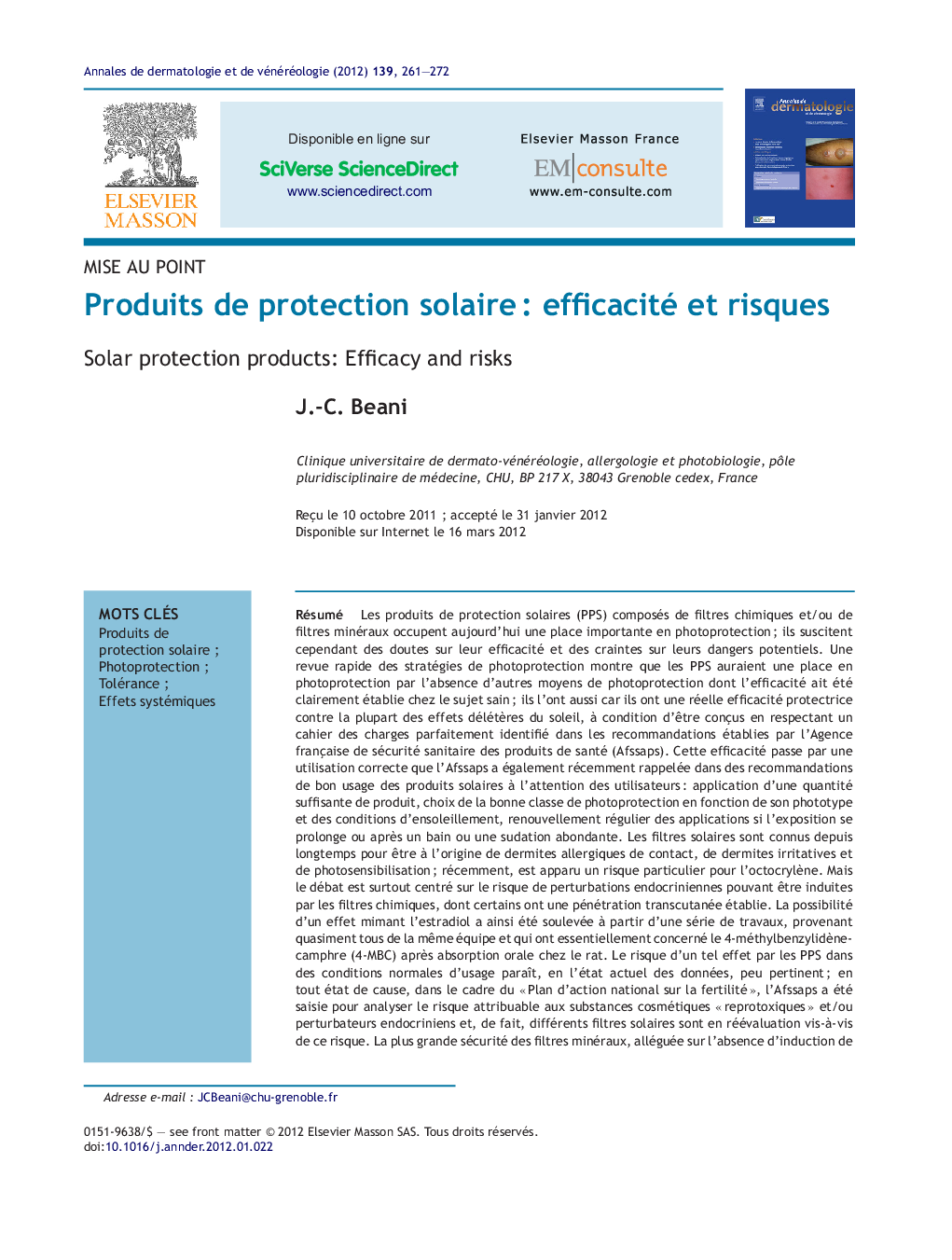| کد مقاله | کد نشریه | سال انتشار | مقاله انگلیسی | نسخه تمام متن |
|---|---|---|---|---|
| 3187754 | 1200940 | 2012 | 12 صفحه PDF | دانلود رایگان |
عنوان انگلیسی مقاله ISI
Produits de protection solaire : efficacité et risques
دانلود مقاله + سفارش ترجمه
دانلود مقاله ISI انگلیسی
رایگان برای ایرانیان
کلمات کلیدی
موضوعات مرتبط
علوم پزشکی و سلامت
پزشکی و دندانپزشکی
امراض پوستی
پیش نمایش صفحه اول مقاله

چکیده انگلیسی
Solar protection products (SPP) containing chemical filters and/or mineral filters are extensively used today in photoprotection; however, concerns continue to be voiced about their efficacy and about their possible dangers. A rapid review of photoprotection strategies shows that SPP owe their photoprotective effect to the absence of other photoprotection methods having clearly established efficacy in healthy subjects; in addition, they exhibit real protective efficacy against the majority of harmful effects of solar radiation, provided they have been devised in keeping with the specifications clearly set out in the recommendations of the French Medicines Agency (Afssaps). Such efficacy is dependent on their correct usage, recently reiterated by Afssaps in its recommendations to end-users concerning the good use of solar products: application of adequate quantities of such products, selection of the appropriate photoprotection class based on phototype and conditions of exposure, and regular renewal of applications in the event of prolonged exposure and after bathing or profuse sweating. Solar filters have long been known to cause contact allergic dermatitis, irritative dermatitis and photosensitisation, and a particular risk has appeared with the use of octocrylene. However, debate has centred primarily on the risk of endocrine disturbance potentially induced by chemical filters, certain of which exhibit established transcutaneous penetration. The risk of mimicry of an effect of oestradiol has been raised on the basis of a series of studies, almost all of which were carried out by the same team, and which mainly concerned 4-methylbenzylidene-camphor (4-MBC) following oral absorption in the rat. The risk of this type of effect with SPPs under normal conditions of use seems fairly remote according to the current state of knowledge; in any event, within the context of the “National Fertility Action Plan”, Afssaps has been formally requested to analyse the risk associated with cosmetic substances that are “reprotoxic” and/or affect endocrine function, as a result of which various filters are currently being reassessed for such risk. The greater alleged safety of mineral filters, based on the absence of introduction of risk of photosensitisation (as a result of which they are preferred for use in young children), no longer seems so clear since the introduction of titanium dioxide (TiO2) and zinc oxide (ZnO) in the form of nanoparticles. Afssaps drew up a risk assessment report concerning cutaneous penetration, genotoxicity and oncogenesis for TiO2 and ZnO in nanoparticle form; further studies are needed before any general conclusions may be drawn. The European Scientific Committee on Consumer Safety (SCCS) is also carrying out an evaluation of the use of TiO2 and of ZnO as UV filters. Finally, current data do not suggest that SPPs exert any harmful effects by inhibiting the beneficial effects of the sun, in particular, vitamin D synthesis.
ناشر
Database: Elsevier - ScienceDirect (ساینس دایرکت)
Journal: Annales de Dermatologie et de Vénéréologie - Volume 139, Issue 4, April 2012, Pages 261-272
Journal: Annales de Dermatologie et de Vénéréologie - Volume 139, Issue 4, April 2012, Pages 261-272
نویسندگان
J.-C. Beani,